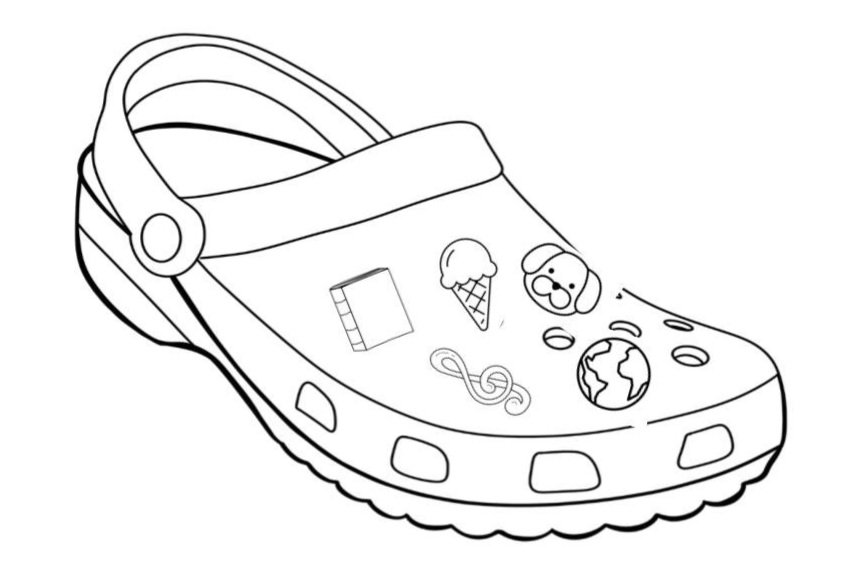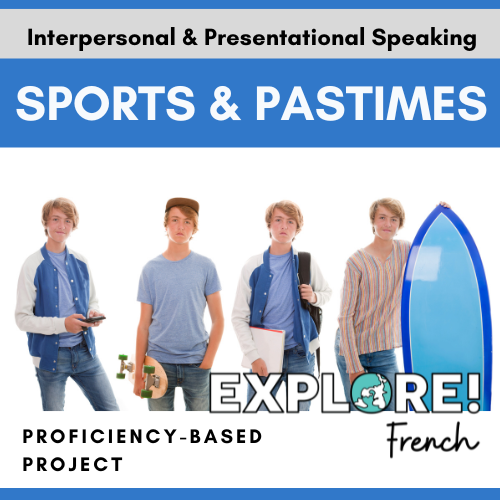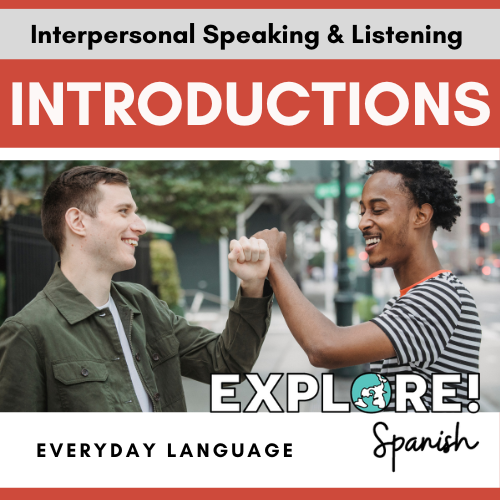Interpersonal Speaking Activities for Novice Learners
For beginners, true interpersonal speaking practice is a challenge. These activities make it possible!
If you surveyed your world language students, what would they identify as their biggest need?
I did just that, and the results were not surprising: over 80% of my students selected “improving my speaking comfort and fluency” as their number one goal.
“Speaking is getting easier to the point where I can add in more of my personality in the conversation”
When our kids come into our classes, they imagine themselves leaving as ‘fluent’ target language speakers. Of course, most students underestimate the long journey required to develop linguistic proficiency. As teachers, we can help by creating an immersive, proficiency-based classroom where students have lots of opportunities to practice speaking and to receive feedback.
So how do we get students - especially novice speakers - to engage in true interpersonal communication? These activities can help!
Graduated Speed Dating
Many teachers are familiar with “speed dating”, a practice format where students rotate among partners to practice multiple times. (If you haven’t tried speed dating, you can read all about it here).
Graduated speed dating is a way to add structure and scaffolding to a speed dating exercise.
Students start with a written assignment and scaffold it through speed dating to act as presentational speaking and then interpersonal speaking.
Before Speed Dating: students write four sentences about each of their classes.
During speed dating: arrange students in two concentric circles or two lines; after each round, students rotate to a new partner. (Here’s a demo:)
Speed Dating Rounds 1 & 2: Presentational Speaking with notes
Each student reads what they wrote about their classes to their partner and listens while their partner reads. The goal here is to develop some comfort with the pronunciation of what they’ve written. The teacher circulates during rounds 1 and 2, listening for student pronunciation or other significant errors. If needed, the teacher can and give quick full-class coaching, reminders, or tips in-between rotations.
Rounds 3 and 4: A step toward Interpersonal Speaking with notes
Student A reads about one class. Student B must make a response to what student A said and then give their opinion about that class. Appropriate responses could be, “I agree,” “Me too,” “I disagree,” “Really?” etc., followed by their own opinion. This is a step toward interpersonal speaking; partners must begin to listen to each other and respond more spontaneously.
Rounds 5 and 6: Deeper Interpersonal Speaking with notes.
This time, after Student A reads one or two sentences about a class. Then Student B must ask a question. For example:
“I really notice how much more comfortable (my partner) got as we spoke more. At first it was nerve wracking, but she got way more fluent after the first round”
Student A: I don’t like history class. It’s boring and I don’t like the teacher.
Student B: Who is your teacher?
Student A: Mr. Baker.
Student B: Oh, I don’t like Mr. Baker either. He’s strict. I have Mrs. Ellis for History. She’s nice and the class is easy.
With preparation and scaffolded practice, novice students can begin having conversations like the one above. This is deeply encouraging to our kiddos!
Rounds 7 & 8: More spontaneous interpersonal speaking without notes
For the last two rounds, I tell students, “Now you’re going to do the same thing as last time: partner A gives a statement, partner B asks a question, and you actually talk. Only THIS time, I want you to try talking without looking at your paper. If you need to peek, it’s OK, but do your best not to look.”
And… they can do it! One student told me, “By the time we finish speed dating, I could talk about all of my classes without any notes.” That’s a win!
Administer Surveys
Kids LOVE taking surveys on social media, and taking online surveys and writing your own is a wonderful way to integrate current trends. (Read my ‘Using Social Media Quizzes’ post for more ideas!)
Developing and administering a survey to their classmates is a wonderful way to practice interpersonal speaking. My guidelines are as follows:
Write your survey questions using the “you” verb form.
For each question, write four possible answers using the “I” form.
Example:
Question: Do you have a pet?
A Yes, I have a dog.
B Yes, I have a cat.
C No, I don’t like animals.
D No, I want a pet but my mom won’t let me get one.
When the student is giving the survey to his classmate, he will ask the original question. Then, based on his classmate’s answer he will ask a follow-up question to get the best answer choice.
Example 1:
Author: do you have a pet?
Classmate 1: Yes.
Author: Do you have a dog or a cat?
Classmate 1: I have two cats.
(the survey author will record answer B and move to another classmate.)
Example 2:
Author: Do you have a pet?
Classmate 2: No?
Author: Why not?
Classmate: I’m allergic to cats.
Author: So, do you like animals?
Classmate: No.
(The survey author will record answer choice C and move to another classmate)
Students may need some demonstration and coaching to see how they can ask increasingly focused questions to find the information they need. This investment is worthwhile, because it teaches students the skills they need to enter into real, spontaneous conversation.
The Clog Project facilitates meaningful interpersonal speaking!
The Clog Project
This is a fun visual activity my middle school students love. My kids are obsessed with footwear, and one of their favorites is a rubber clog with individualized charms. I harnessed this obsession for interpersonal speaking!
I give students a paper clog with cut-out charms representing whatever we are studying. (This works especially well for personal introductions and for pastimes). Students must create a clog with at least 5 charms representing themselves.
Then we do a speed dating or other format where students use the clog as a prop to describe themselves to their partner. After each charm, students must ask their listener a question about that activity.
We took our clogs to the neighboring elementary school and did this exercise with French elective classes. In class we worked on techniques to support the younger students’ understanding through gestures and the visual support on our clogs. My students asked the younger kids, “Do you like soccer?” “Do you like reading?” And the younger students were able to get it! This activity was very encouraging to my students, and also helped support our feeder program. Win-win!
Here’s a ready-to go Clog project for pastimes in French, Spanish, Portuguese, Chinese, and ELL.
Introduction Cards
Create a card deck. On each card, include a photo of a teenager, their name, age, nationality, and a few images to represent things they like.
Each student gets a card. They must approach a partner and have a conversation introducing themselves as the person on the card. At the end of the conversation, switch cards and repeat.
This is a simple but effective activity to get kids speaking almost from the first day of class. As students progress in proficiency, the conversations can become more detailed and sophisticated.
Here are my Introduction Cards in French, Spanish, English, and Portuguese.
Conversation Templates
I’ve written about Conversation Templates before, so read more here. These are my favorite tool for interpersonal speaking practice, and students respond really well to them. I have a huge collection, including some free samples, on my TPT store.
Remember that student survey, where students expressed their desire to speak more comfortably? Incorporating lots of interpersonal speaking practice makes a huge difference, and students notice! After graduated speed dating, one student commented, “I really notice how much more comfortable (my partner) got as we spoke more. At first it was nerve wracking, but she got way more fluent after the first round.” And another student told me, “Speaking is getting easier to the point where I can add in more of my personality in the conversation”.
These students are well on their way to proficiency! Woohoo!





